© 2025 ALLCITY Network Inc.
All rights reserved.

The story of Valeri Nichushkin’s odyssey through the NHL is pretty well-worn territory by this point. When he landed in Colorado late in the offseason after being bought out by Dallas, he was coming off a season where he scored zero goals and just 10 assists in 57 games.
It wasn’t even like the Stars weren’t playing him. 57 games and he averaged 11:55 of ice time that season. Looking back on it now, it’s unfathomable he had a season that terrible. Honestly, it’s unfathomable that anybody had a season that terrible given hockey’s randomness and that level of opportunity.
As Nichushkin gets set to hit unrestricted free agency this summer at age 27, he’s having a career year where anecdotally it has felt like he’s been Colorado’s best player during some stretches of the season.
The counting stats are great. Through 61 games, he’s recorded 52 points (25 goals, 27 assists), which blows away his previous best of 34 points and 14 goals (both his rookie year back in 2013-14).
When you look at the career-high in both goals and assists, there are some caveats there. For goals, he’s shooting a career-best 14.3% and averaging by far the most ice time he’s ever seen in the NHL at 18:55. Before this year, he had never averaged even 15 minutes per night, so the substantial leap has given him more scoring opportunities than ever before.
Nichushkin has also spent almost the entire season in Colorado’s top six so his quality of teammates is higher than ever before, too. His most common linemates, in order, at 5v5 this season are Nazem Kadri, Andre Burakovsky, Nathan MacKinnon, Mikko Rantanen, and Gabe Landeskog.
That’s the best possible company the Avs have to offer.
In digging into where Nichushkin has become Colorado’s most malleable forward, I want to look and see first at his isolated impact and then see the difference he has made in various forward alignments this season.
Let’s start with where Nichushkin’s isolated impact is. This is essentially what Nichushkin has accomplished on the ice in a vacuum.


As a reminder on the first chart, plus percentages on offense are good and negative numbers on defense are good. This has Nichushkin driving play 12% better and suppressing offense 9% better than league average.
As we see here, basically the only thing Nichushkin isn’t above average at is creating offense on a power play. Given his skillset and all, that’s not really a huge surprise. Also, when you have the kind of talent around him he does, the Avs simply don’t need that from him.
I love comparing players to their own histories because it gives you an idea of how they’ve changed over the years. Here’s Nichushkin’s entire career arc in the form of that first graph.

In his final year in Dallas (2018-19), the disastrous 10-point campaign that resulted in the Stars paying him to ultimately play for the division rival Avalanche, you started to see the formation of the player he has become in Colorado.
The elite shot suppression he showed in that final campaign in Dallas continued in Colorado as he used his enormous 6’4″, 210-pound frame and good skating to maximum effect. He was an aggressive forechecker whose truly elite skill was simply winning puck battles.
When the goals started to drop for Nichushkin, it seemed as if the frequency of him scoring only started to go up, culminating in his excellent season this year being promoted into Colorado’s top six.
If you refer back to the JFresh player card, you’ll see his quality of teammates and competition are among the absolute highest in the league. That makes his defensive contributions, which haven’t dipped a bit, and improved play-driving and finishing all the more impressive.
It’s one thing for a middle-six forward to improve against similar competition. For Nichushkin to take the step up in Colorado’s lineup and improve in the same year is very impressive.
In looking back at his career arc above, you can see a player who had clearly dominated his role last year and the Avs gave him an opportunity to show more this season. He took that chance and has run with it, probably straight to the bank because he’s made himself arguably Colorado’s most valuable pending free agent forward.
Before transitioning into the impact on his linemates, I wanted to drop one more interesting data point for Nichushkin. Genuinely, I didn’t have a great place to put this but it’s more information on what makes him so effective, so I had to find a spot for it. That spot is here.
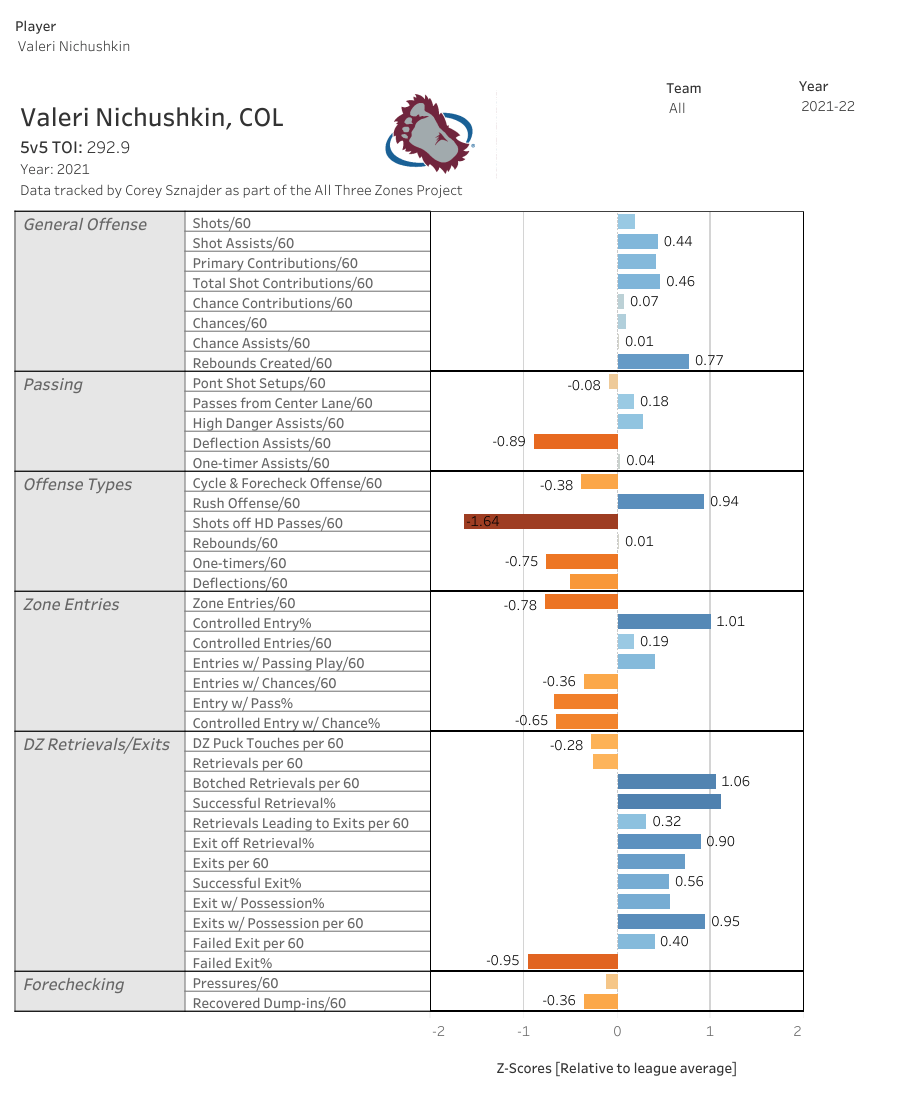
This really drives home where you see Nichushkin shining the most. He’s an excellent transition player who surprisingly struggles a little to create offense from the forecheck but is constantly looking to put the puck in the middle of the ice or on net.
Defensively, he just wins puck battles. His retrievals are great and when he gets a hold of the puck, he consistently gets it out of his own zone and moves it up ice (remember: excellent transition player). He gets up the ice with control and enters the attacking zone with the puck on his stick. It’s a perfect fit for how the Avalanche play, something he should consider when mulling over his future this summer.
Now, as promised, the impact he has on his linemates. Best place, as always, to start is WOWYs (With/Without You).
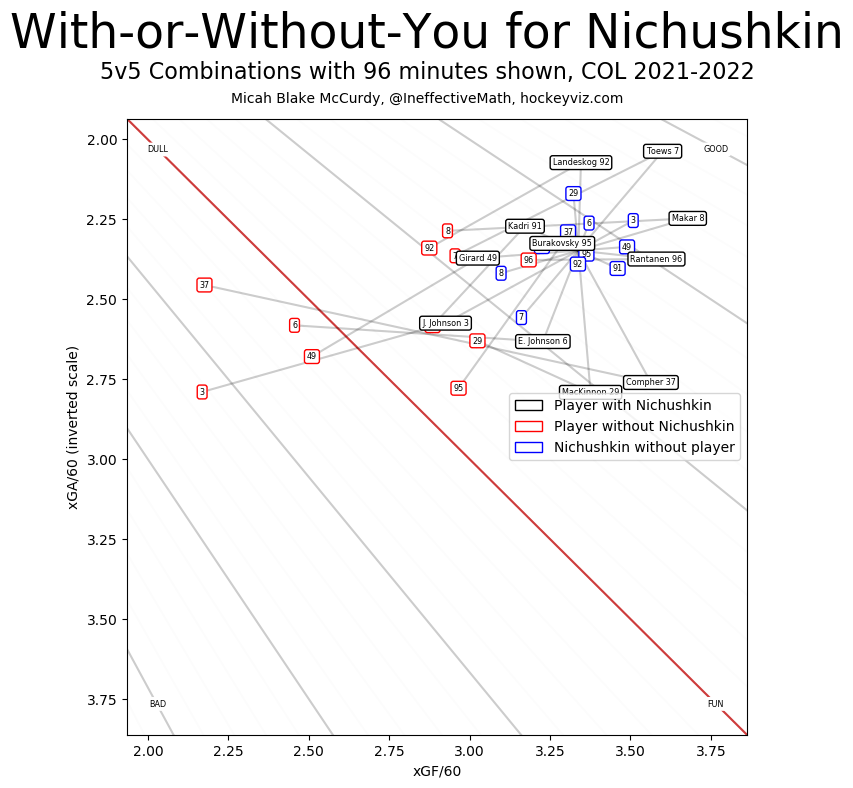
Here we see some really interesting results. The easiest takeaway is that basically everyone gets better playing next to Nichushkin. I don’t think that’s an exaggeration either. Pretty much all of the players on that graph improve when on the ice next to Valeri Nichushkin. It’s remarkable.
For that graph, the red line is the break-even line going all the way down. Being on the right side of that red line is good, being on the left is bad. Just four players are there without Nichushkin, and Jack Johnson is the most obvious one who is very much in that area without Nichushkin (a very common theme for J. Johnson this year, but that’s a different article entirely).
At the start of the season, before this weird injury-plagued season began, the plan was to have the top six constructed like this:
Landeskog – MacKinnon – Rantanen
Nichushkin – Kadri – Burakovsky
Those two lines have had some time to play together, especially the top line there. Before getting into anything else, let’s just see how the “ideal” top two lines have performed this year.
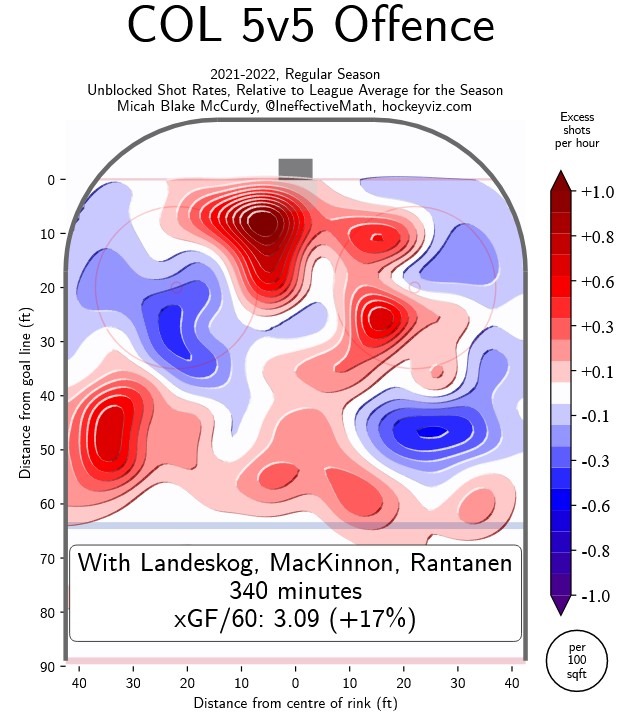
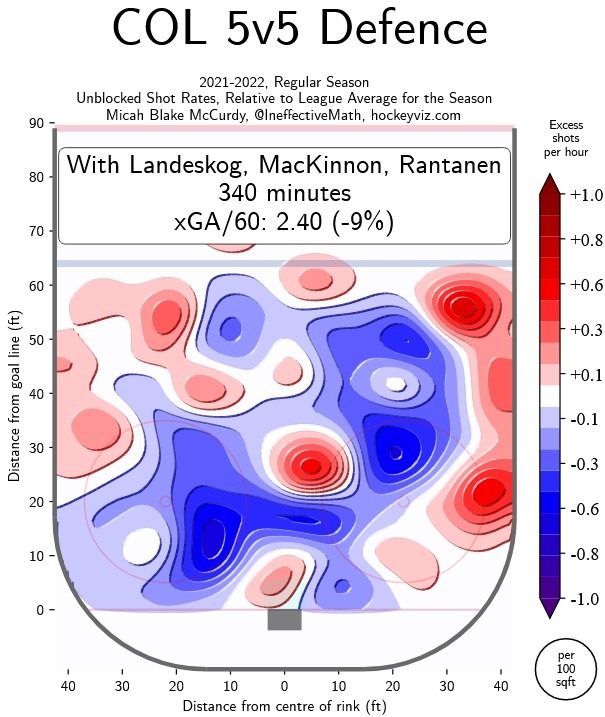
So, uh, that line is still pretty dominant, even with some issues such as MacKinnon’s early-season “struggles” (it’s all relative, right?) and Rantanen anecdotally cruising through entire games. Despite that, Rantanen produced a career year and Landeskog was well on his way to one before knee surgery.
That’s a true top line. Now for the second line.
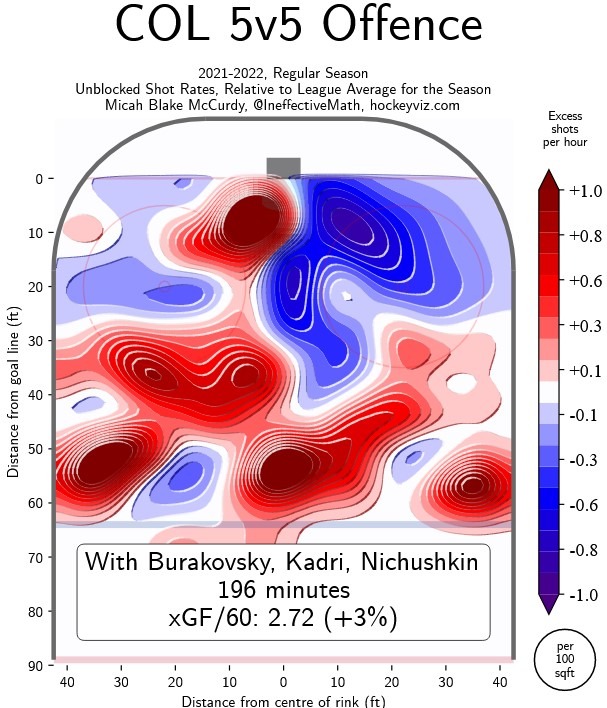
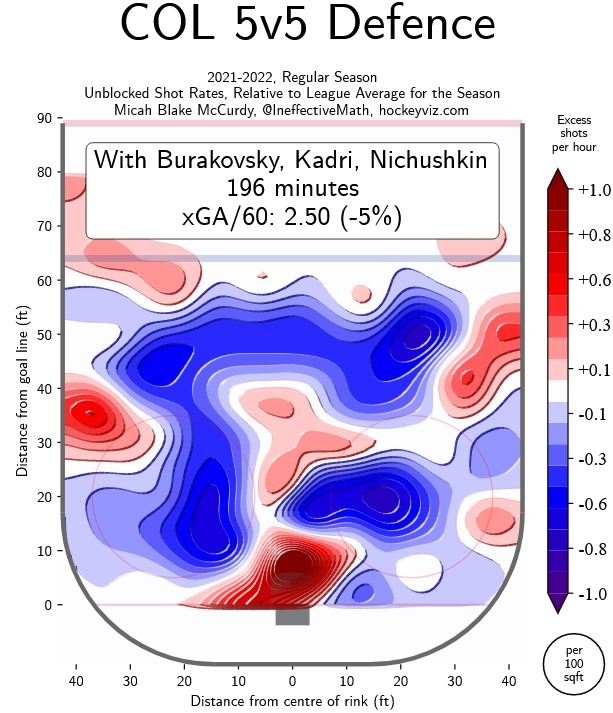
Nowhere near as dominant, but remember the percentages are relative to league average. That means Colorado’s second unit has been 3% better offensively and 5% better defensively than a league-average line.
It’s not dominant, but it’s pretty damn good. When you also realize that literally all three of those players are having career years (and also all facing unrestricted free agency for the first time), this is inarguably an effective group.
After Landeskog opted for knee surgery back in mid-March, Avalanche head coach Jared Bednar decided to put Nichushkin up on Colorado’s top line as the go-to move. While Burakovsky also spent some time up there, Nichushkin has gotten the most burn, and, well, if the results weren’t interesting, I probably wouldn’t be writing this right now, would I?
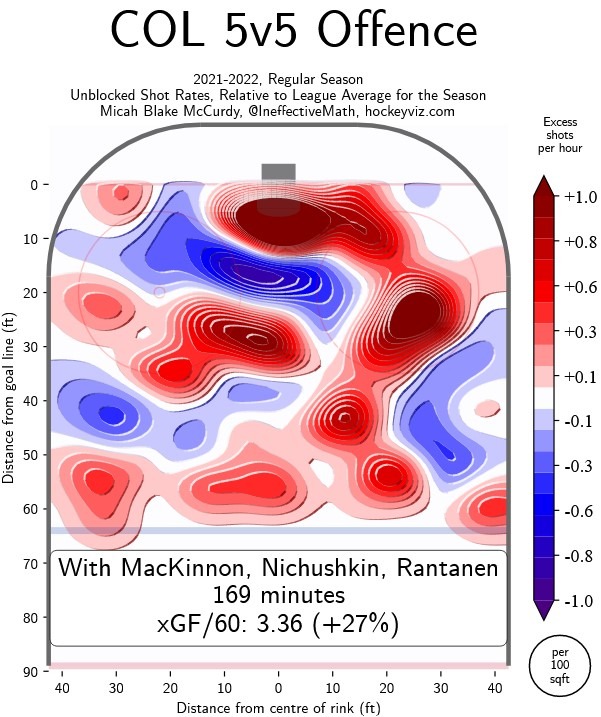
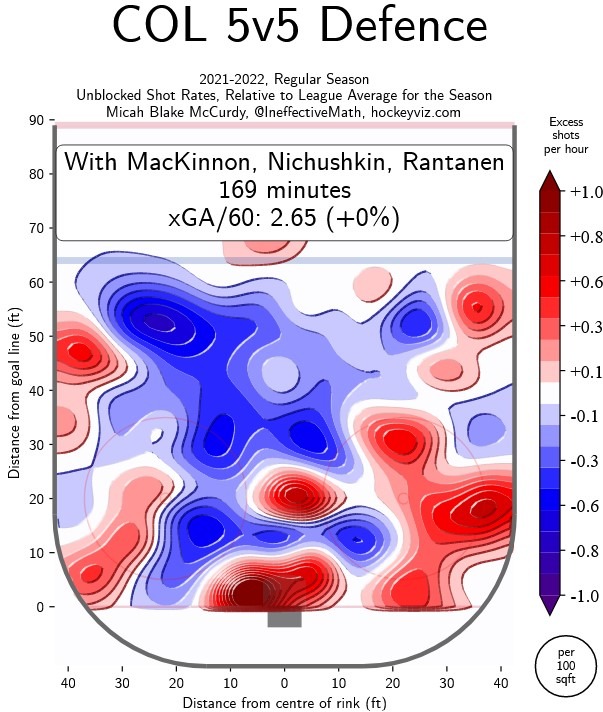
These results surprised me quite a bit. Basically, Nichushkin supercharged the offense, putting that trio at 27% better offensively than a league-average line. Defensively, however, despite Nichushkin’s well-earned reputation as a defensive ace, that group produced just league-average results in its own end.
There’s an opportunity cost to every player moving up in the lineup, however, so let’s see what happened to Kadri and Burakovsky in the stints this season without Nichushkin for context.
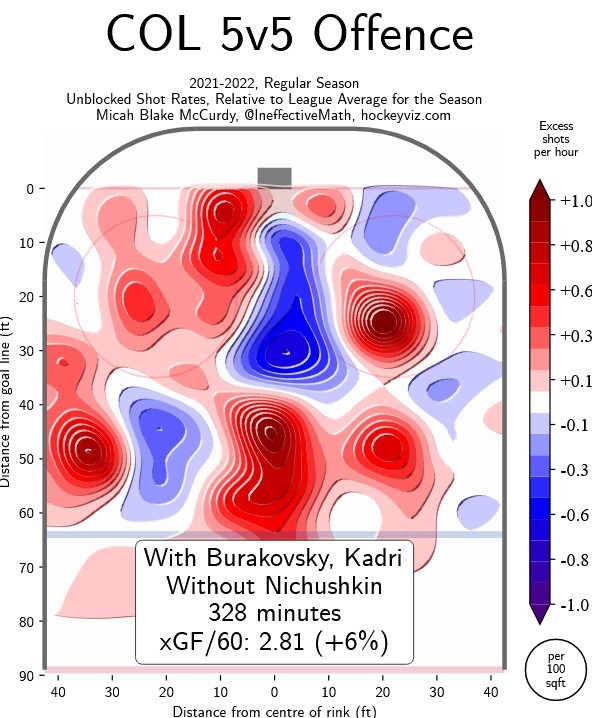
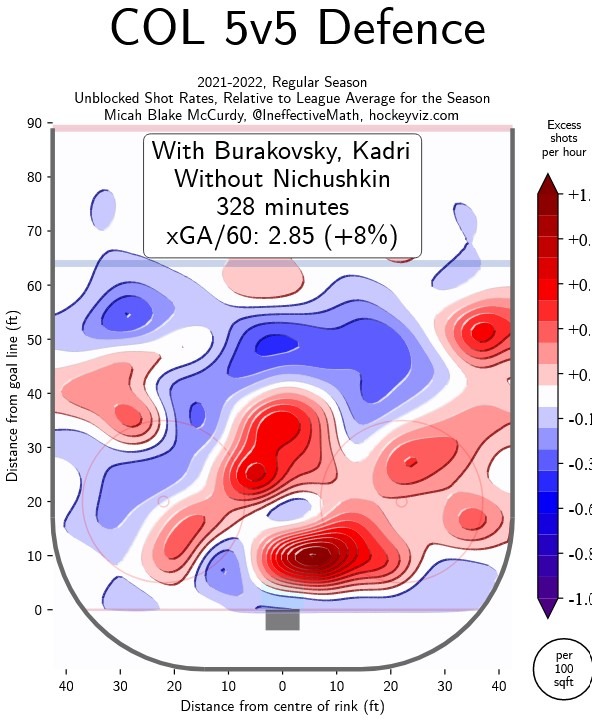
Offensively they remain excellent. Kadri and Burakovsky have combined for 145 points between them this season so it’s not hard to believe they have found their way on that side of the puck without Nichushkin’s assistance.
Defensively, however, you see that they collectively give back everything they produce. That’s obviously a problem, but one the Avs are uniquely positioned to address.
If you’re a person who only cares about the end results and isn’t worried about all this process mumbo jumbo, which is the crux of this entire piece, well you’ve done a lot of reading just to get to this point so thanks for sticking with me to this part.
When we’re talking about how the different combinations here have actually done in, you know, the goals department, you see a familiar picture emerge.
Landeskog – MacKinnon – Rantanen: 19 goals for, 9 against.
Nichushkin – Kadri – Burakovsky: 9 goals for, 11 against
Nichushkin – MacKinnon – Rantanen: 10 goals for, 6 against
There are obviously time on ice differences and I won’t delve into all of the different rate stats, but I will say the picture painted is pretty clear. The Avs are still at their best with the three-headed monster intact but don’t lose nearly as much value as you would have previously thought when Nichushkin slides into Landeskog’s spot.
How Bednar chooses to utilize the options he’s expected to have available to him in Game 1 of the playoffs when Landeskog and Rantanen are back will be very interesting given the results we see here.
Without getting sidetracked into the postseason lineup conversation, this really shows what a valuable player Nichushkin has been for the Avalanche this season
It was a big leap of faith in moving him up the lineup at the start of the year and seeing how he’s taken the ball and run with it has created a fascinating conversation surrounding the team’s decisions this summer with all of Nichushkin, Kadri, and Burakovsky (among others) facing the open market.
Having a career year always helps, but seeing the more nuanced impact on the lineup thanks to Nichushkin tells you how he’s morphed into their ultimate Swiss Army Knife.
Where Nichushkin goes, so goes the train of success.
Comments
Share your thoughts
Join the conversation



